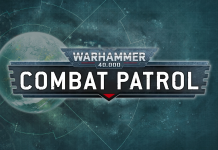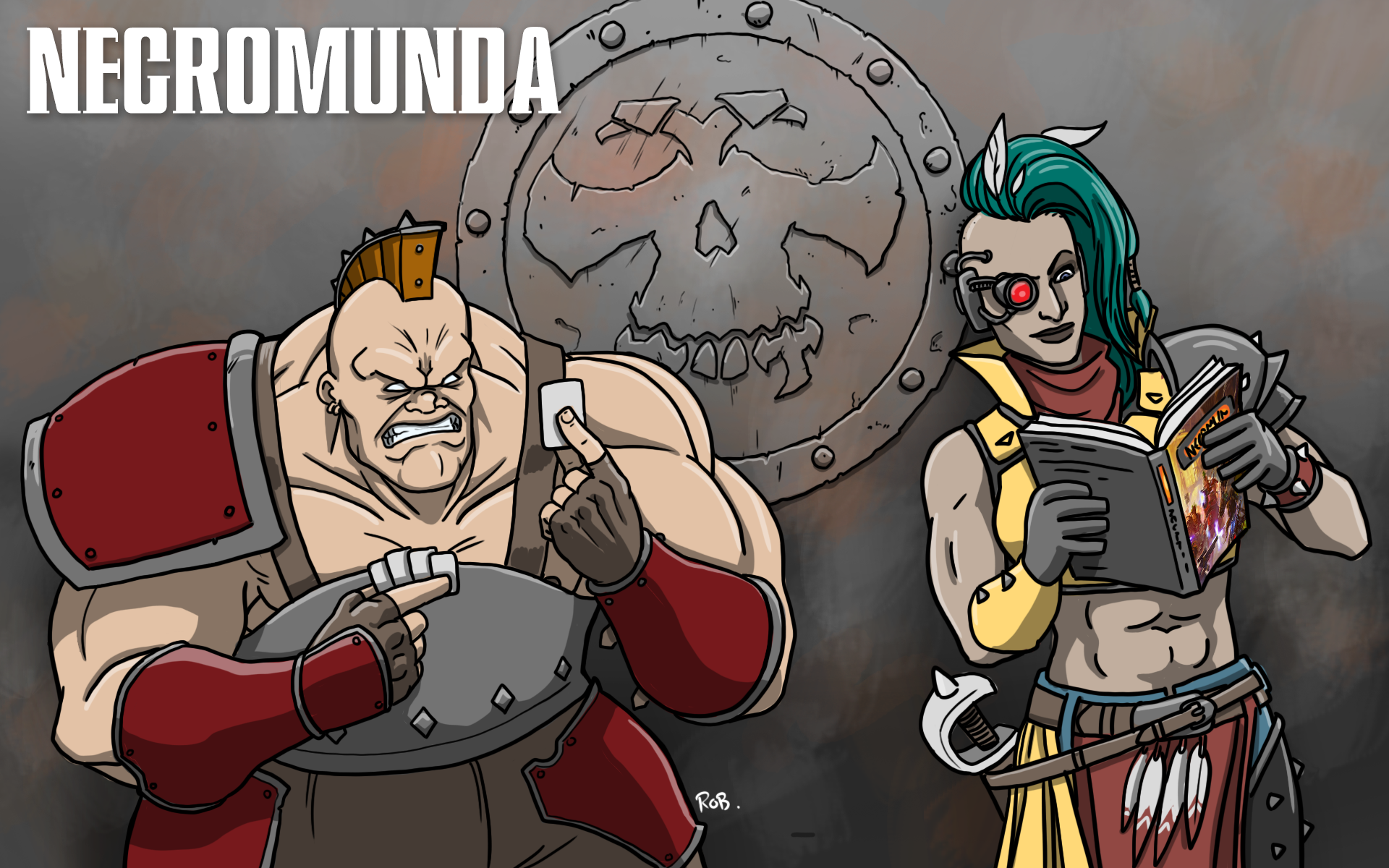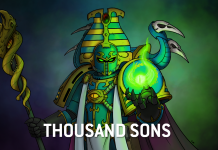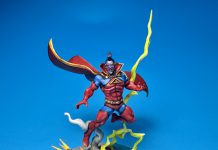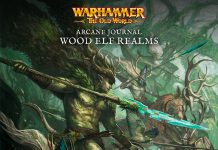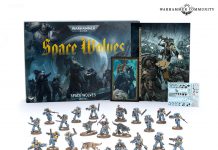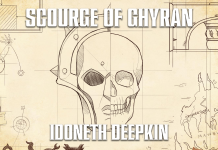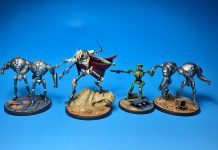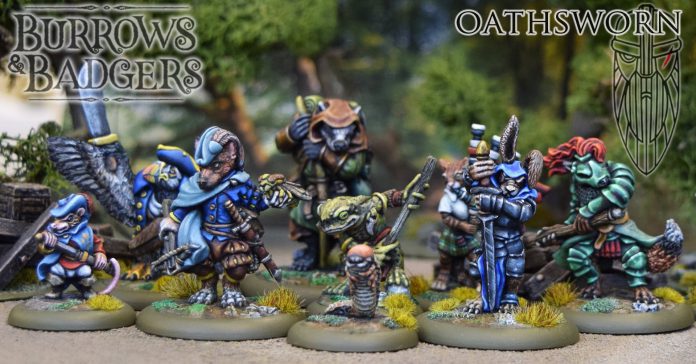Bair recently sat down with Michael Lovejoy, the creator of Oathsworn Miniatures. Michael has a storied history with wargaming, sculpting, and has created the anthropomorphic fantasy skirmish game Burrows and Badgers. I could give a longer intro, but that’s just going to spoil some of the interview…so a big thanks to Michael for speaking, this conversation could have easily gone on for hours!
Oathsworn Miniatures
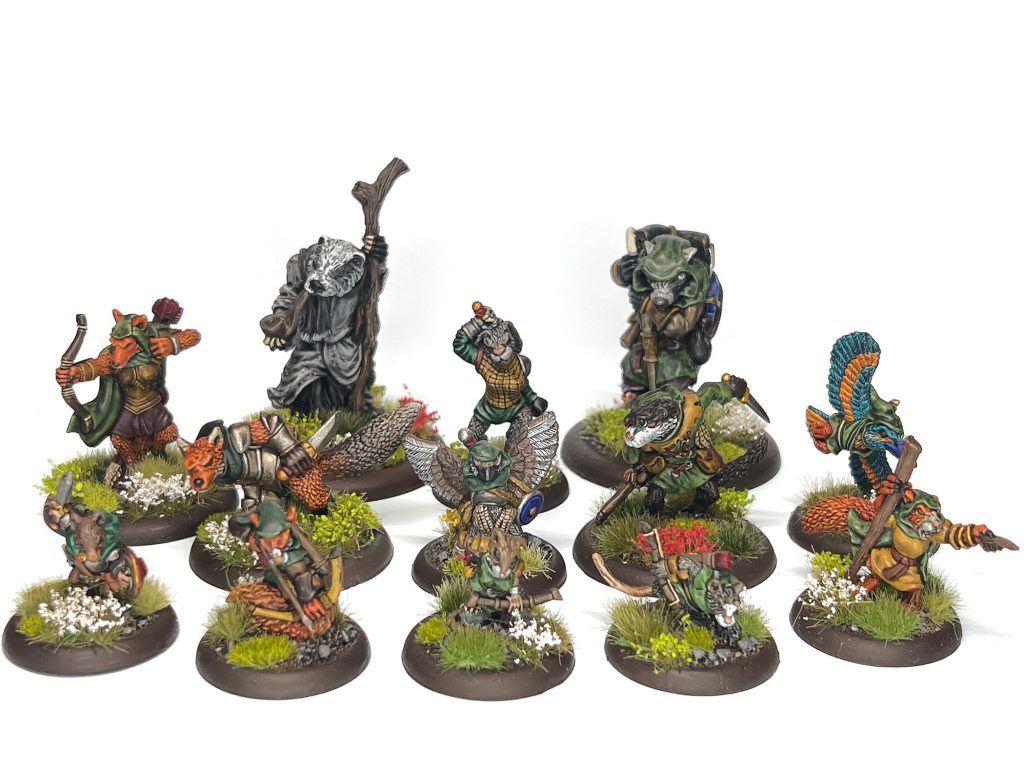
Bair:
So about you first, what’s your introduction to miniatures and war gaming? Where do you come from?
Michael:
Started gaming ’83 with first edition Warhammer, a bit of D&D Red Box, but I didn’t really like role playing. I preferred the tabletop battles and the skirmish part of it, but when the first edition of Warhammer came out in ’83, I was about 10, so it didn’t make an awful lot of sense to me at the time. I did my best with it, and got some of the early Citadel miniatures from there and then kind of continued on with Games Workshop stuff for right through until about 2000, really. I briefly worked for them in a couple of shops and then I’ve just went on doing freelance painting and sculpting. And then a few years of freelance sculpting for different companies before doing my own ranges, really, just because you get a bit fed up doing the same. There’s only so many times you can do Napoleonic British and not get fed up with it.
Bair:
Was it mostly historicals then, the freelance stuff that you were working on?
Michael:
Yeah, it was a mix, really. It depended on who you were working for. I did a lot of 15mm historicals, a lot of six mil sci-fi, and then odd stuff that wasn’t for war games companies. Like I did various bits of jewellery for people, I did broaches and things, and basically whatever work was available, just if it was sculpting,
I’d do it. Got to pay the bills.
Bair:
About Oathsworn, your company, how big of an operation are you? Or how small, maybe? When did you start?
Michael:
Yeah, small is probably the right word. It’s literally me and my wife. We do everything. About 10 years ago. This is our 10th year, so yeah. I’ve been doing freelance sculpting for other people for a long while. I just thought it’d be nice to do my own stuff. We started out with a range of dwarfs on Kickstarter, did that and kind of developed from there. After a couple of years doing fantasy miniatures, somebody said, oh, I should try doing some anthro stuff. So I just literally threw together three or four minis and just put them on the Internet and said, “Okay, is that the kind of thing you’re thinking of?” For background, I’ve had a lot of work doing horses and things and dinosaurs and things for different collectibles companies, so I’d already done quite a lot of animal stuff. So I was generally pretty decent at doing animals. So the anthro stuff just seemed like an obvious fit.
Bair:
You’re beating me to my next question but what came first, the idea behind the game or the miniatures themselves? Sounds like it was the minis first?
Michael:
Yeah, it was definitely the miniatures. It was only after we did a Kickstarter for the first set of about 20 of them, and then people were kind of, “What do we do with them?” and generally, I thought…paint them, you collect them, you can use them in whatever games you fancy. But people want a specific game to use with them, so I had a crack at writing the first set of rules.
Bair:
The rulebook is available through yourself but also Osprey, you worked with Osprey on the first set of rules or how did that come about?
Michael:
No, the first set, the little paperback set, which we did ourselves, it was, yeah, just a tight… I think we only did about a hundred. It was only printed run of about a hundred. We did that, took it to Salute and the UK Games Expo and it was when we were at the UK Games Expo, Phil Smith from Osprey Games, he came across and he liked the look a bit, bought a copy, and he obviously looked at it in his hotel room, came back the next day and said, “Oh, we’d be interested in doing a proper version of it for you.” So then it developed from there.
Bair:
Awesome. So the models themselves obviously you do the sculpting, but do you do all the moulding and everything in-house?
Michael:
No, the moulding is done elsewhere, we’ve had a number of places do it over the years. I keep meaning to buy a moulding press but that’s another £5k and then I need space for it, and also have to learn how to actually do the moulding properly. I have done resin moulding before but it’s a different process for metal so we get them made. We do all the casting in house normally but for large bulk orders like a new Kickstarter we contract that out so it’s done more quickly. We have a casting machine so we do the day to day casts.
Bair:
Speaking of resin and metal casting, almost all of your minis are metal except some of the largest like badgers, is that a practical decision or some other limitation?
Michael:
The first few of the big ones we did have in metal to begin with. So a couple of the badgers and that were in metal but you just get casting problems with them really. When they’re single piece models just the sheer volume of it overheats the moulds, so you get burning and pitting on the model and the moulds don’t last very long. And then it just puts limits on things. Once we switched to resin, we could do things like the red kite, which it’s just a position that you couldn’t do in a metal mould. It just gives us better options and has made a big difference on postage since they’re so much lighter.
Bair:
We’ve also noticed that the models come pre-cleaned. Lenoon was even actively looking for a mould line to clean on his moles…but there just weren’t any!
Michael:
Ha yeah I just get a bit carried away. It’s one of the things we’ve found is that because they’re single piece models and a lot of people who aren’t into war gaming like them when we’ve had them at the UK Games Expo and things and board gamers and role players will pick them up but don’t have much experience with miniatures. So we’ve got a lot of new people coming into it and I was noticing that people were not cleaning the mould lines, they were just painting them and it was really starting to bug me. I shouldn’t, really, it takes forever…every day I’m standing here when the orders come in and I’m busy filing away. Once you get a reputation for things being good you’re kind of stuck, you just have to keep doing it, it’s what people expect. I like the customers to be happy anyway.
Bair:
And it’s no small number of miniatures either, you have about 200 now in the Burrows and Badgers range by my count.
Michael:
I think that’s right, about 180 product lines for Burrows and Badgers but some have a few minis in them like the Stoatbarts and mist ghast sets. I’ve got another 20 odd in progress at the minute so will surpass that in another month or two.
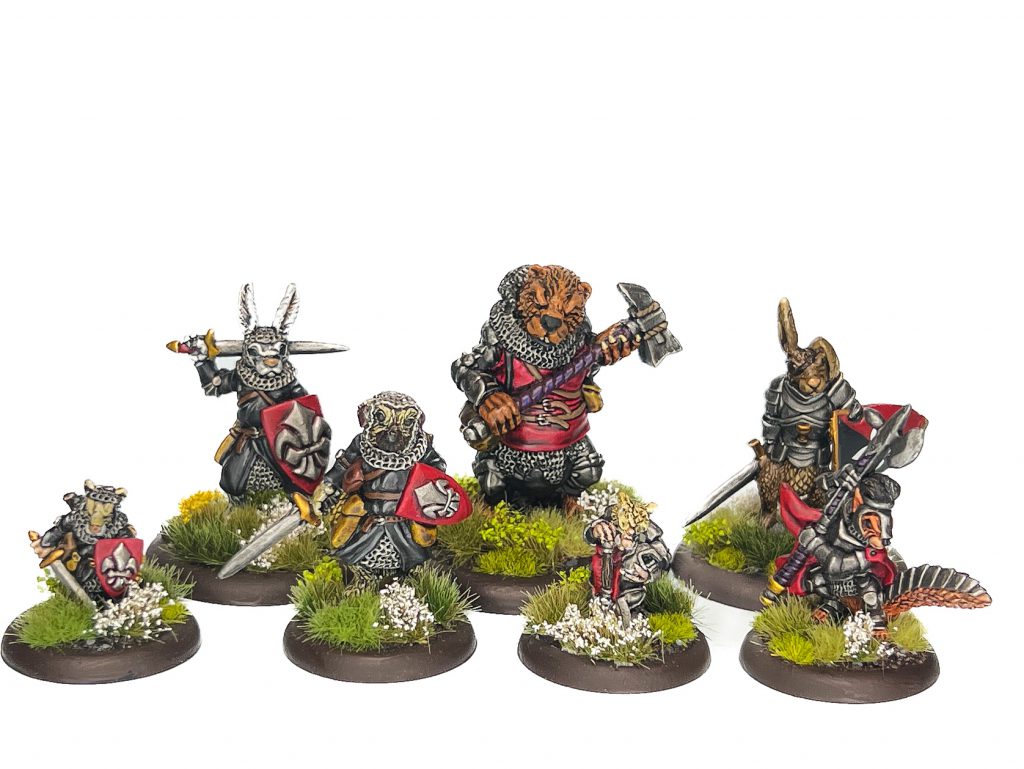
Bair:
I love that you share work in progress shots of your sculpting to the Burrows and Badgers facebook page and your instagram account. All being done by hand in greenstuff. What can we expect to see next?
Michael:
It is difficult to say. My initial plan was to have a Kickstarter out April or May this year. And I’m just so far behind. There’s so much to do. It’s the day-to-day running. Today I had a couple of sculpts I wanted to get finished off, but I’ve been spending the day doing a return instead. So hopefully over the weekend I’ll get some sculpting time. But it’s just that problem: the day-to-day business stuff takes up so much time that I seem to always be behind on sculpting. And obviously, we’re also working on new rules as well and that takes up time that… It’s an endless problem.
Bair:
When you’re sculpting do you get halfway or nearly done a mini and just scrap it entirely, or do you try and salvage some of that work normally?
Michael:
Very often, stuff just doesn’t pan out the way you expect it to, really. I’ve got aphantasia, which means I can’t see pictures in my head properly, so I don’t actually have ideas for the models when I start. I have to say to myself, “Okay, it’s going to be standing like that model and I’ll give it similar equipment to this one…” and then I just have to start sculpting. And quite often I’ll get towards the end and realize that that’s just not going to work. It’ll never be castable or it just doesn’t look quite right. And so I end up throwing away quite a lot of stuff which is always annoying. It’s all time down the drain, but it’s all practice at the end of the day too.
Bair:
Do you find yourself needing to change the minis, even if you’re happy with them, just so that they can be cast?
Michael:
That’s it. It’s the one piece that restricts it, because you’ve only got a kind of flat plane to work with you’ve got to fit in there. You get away with a certain amount on with resin stuff because the moulds are more flexible. They don’t last as long, but they’re more flexible. So you get a bit more with a resin one than you do with a metal one. But yeah, when you’re designing it, you’ve always got to think about where the rubber is going to, how it’s going to wrap around the figure and whether it’ll come out cleanly or not. And we’ve pushed it a fair bit on some of them. But then that means those moulds don’t last as long because they’ll catch in certain areas and have to get a new one made. The integral bases help here, I know some people don’t like them because if you want to base the minis on cobblestone or something it becomes harder to do. But when it comes to casting it gives more freedom, it doesn’t restrict us to that flat tab area.
Bair:
I’ve seen that there’s ongoing playtesting for some new rules on the Facebook page, are these new warbands or something more?
Michael:
Yeah, we’re always adding new bits in like we do in the Oathsworn Journal PDFs that are there to cover whatever I want to put in. I think the last one in there was tunnel jack gangs. I’m kind of gradually adding to it, I want to do something for the hill folk clan because I like the kind of Scottish bit. I feel like they need some kind of rules of their own. There’s got to be something in there about bagpipes or something. I don’t know. I’m not sure what yet, but in the minute I say we’ve got a new edition coming out in 2025, I think it is, with Osprey. So I’m trying to get the core rules set down at the minute, which is…well I don’t want to change too much, but there’s bits that need cleaning up.
Bair:
What needs cleaning up from your perspective?
Michael:
There’s a few things I want to change. Again, you’ve got to be careful how much you change, because you don’t want it to be an entirely different game. We’ve got a play testing group on Facebook for that. And one of the things we’re changing is splitting out moves. Currently we’ve got moves happening in an action. So if you’re doing an attack action you get to make a move and then you get to make an attack action. People get confused by it because, generally speaking, you separate them out. So I’m finally admitting that was the right thing we should have done in the first place and separating moves out, so everyone will have two actions. Then you can either move and move or you can move and attack or that kind of thing just to split that out. It’s simple things like that really that just make it easier to understand. So it’ll be more similar to other games in the basics.
Really I want to cut down on the amount of pluses and minuses for every action as well, make it a bit more intuitive. Maybe not have any minuses at all, I’m not sure yet. I like them on wounds though, I like wounded models to have some kind of problem from being wounded. We’ll see how it goes.
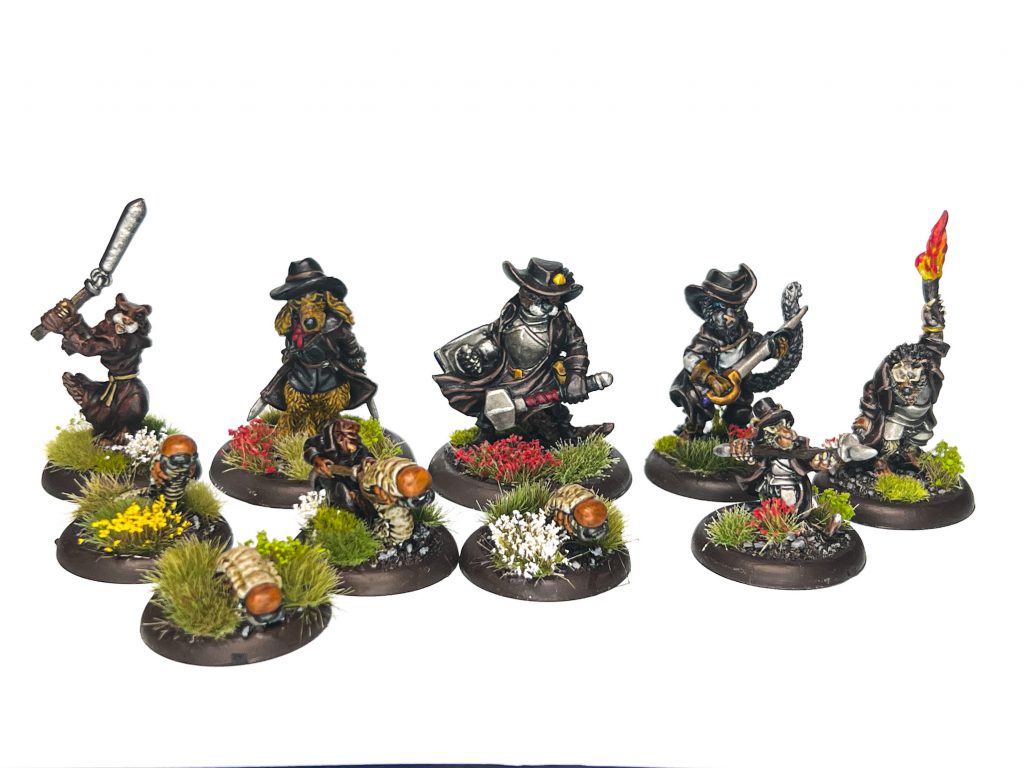
Bair:
Speaking of wounds it’s really interesting that everything has the same number of wounds (16), but then larger models are “tough” so take a reduced number of wounds from attacks, where smaller creatures like bats are “delicate” so take more instead. It isn’t a system I’ve seen used before but it works great.
Michael:
Yeah, the reason I did it that way in the first place was because we had so many different kinds of animal, but we’ve only got the one roster, so you’ve only got enough… I’d either have to do loads of different sections for wounds that half the time you’re not going to be using. So I thought, “Okay, if we can find a way to keep them all with the same number of wounds but have the tougher ones be able to absorb more of it. That way, we could stick with the one roster and just made the whole that side of things easier.” The miscasts, that been a nightmare from day one, really, that just… I was so back and forth on what to do with them. I’m still not a 100% happy with the way they work. Ideally with that kind of warband, with a necromantic warband that you want some way of summoning stuff, it just feels like you should be able to summon things, but when you’ve got a system that relies on number of activations, being able to summon extra stuff really messes up and you end up with loads of extra activations, and then you always win. So it’s just so hard to balance when you can summon things, but we’ll see how it goes.
Bair:
Have you considered any Sci-Fi anthro or sticking with just the fantasy setting?
Michael
Yeah, it’s been suggested a few times. I like sci-fi stuff. I’d really like to do some. The problem is just time at the minute, really. I’ve got loads of things I want to do. I’ve got various other games and things that I’ve started and we’ve done some sculpts for and what have you, but they’re all in boxes. All the time gets taken up with Burrows & Badgers. And while people are wanting to play it and get the miniatures, that’s what we’ve got to stick with, really. But one day, I’ll try and sneak some sci-fi in there.
Bair:
It definitely seems like a successful project then! Has it surpassed any expectations you had for it going in?
Michael:
Oh, yeah. No, it’s good. I think one of the things that’s benefiting Burrows & Badgers is the fact that we’re still doing it. And I haven’t switched on to other projects. You often see, with a lot of smaller games, because obviously we’re happy with the numbers, but compared to something like 40k or whatever, it’s tiny.
And you do see with a lot of the small manufacturers, they’ll put a game out and then six months later, there’ll be a new game. And they’ll be onto something else and they’ll be pushing that, promoting that, and you’ll have a limited range from the first one, and slowly, it dies out and people stop playing it. Whereas obviously with this, you only really need six or seven miniatures aside for Burrows & Badgers and now we’ve got a couple hundred so it gives people options. It’s like people who are really into it from the start have got new stuff they might want to collect, and people who looked at it when it first came out a few years back and thought, “Well, maybe shall I do it or not? I’ll leave it for a bit.”
It definitely helped me, for sure, because I only just found out about it earlier in the year. I went online and said “Oh, there’s really active online community” which is a big part of gaming these days. Like the Facebook page you have for it, which I think has been the most positively engaging community I’ve seen on Facebook. You don’t find such positivity online all the time.
Michael:
Yeah it is a good one, it really is. I think it helps being kind of an animals game. You are only going to be there if you like it. People who don’t like it just aren’t even going to bother showing up. So everyone who’s there is kind of into it. You get a 40k group or whatever, you’re going to get all kinds of people on there. You’re going to get people who are there to play space marines and they won’t like certain other groups of people and you’re going to get a real mixed bag because it’s such a wide kind of group, it’s just a wide community. But with Burrows & Badgers, you’re only turning up if you like badgers with swords and mice with axes and stuff. And once you’re there and you’ve admitted that that’s what you’re into, then everyone’s going to be friendly.
Bair:
Outside of your own sculpting are there other games/miniatures that you play or collect?
Michael:
I collect a lot of other games and I intend to play a lot of the games. I’ve got loads of boxes of unopened stuff and what have you. I don’t get an awful lot of time for gaming. That’s the problem. I’m halfway through an Age of Sigmar Army. I’ve got the usual 40k stuff because I’ve been into 40k for donkey’s years. But if I ever get a chance to play it, we usually play third edition anyway because it’s just the one I preferred. But other than that, I’ve got all sorts on the shelf that I keep meaning to play. Baron’s War stuff, which I’ve got all the armies where I’ve just kind of started building them. I just haven’t got around to finishing it. Strontium Dog, I really wanted to get into. So I started it and again, haven’t had a chance to play it much. But yeah, you know what it’s like. When you’re into the whole industry, you see so many cool things that you think, “Oh, I forgot that.”
So yeah, lately it’s been more that I buy them, they sit on the shelf behind me and haunt me, and one day…
Bair:
Yeah you can’t see my shelves but it’s a bit of the same…
One thing that’s been really enjoyable and Burrows and Badgers is that I can spend a small amount, get a little warband to paint, there’s basically no build time at all and can get through 5-6 minis in a weekend across a few evenings after work. Much less daunting than full armies. And something about painting single piece metal minis is very nostalgic, despite being quite new pieces.
Michael:
Oh, I’m glad you’re enjoying it. I think being one piece helps as well, just in terms of getting them on the table. I think people are painting them and playing them more because there’s less commitment to a large number of models for a force. I’ve got a couple the Horus Heresy box, which I’ve got to get it and build it and I’m looking at the number of bits and the shoulder pads are in half and I’m thinking, “I’m going to be on for weeks building this,” whereas the beauty of a one piece thing is they stick on a base and start painting. So I think that’s helped get people playing the game rather than just buying the miniatures and then sticking them in the corner. I really like the infinity miniatures, I’ve always loved the look of the infinity stuff, but I’ve never actually played it, because every time I go to try and put together a nine piece metal bottle with tiny little attachment areas and you start drilling it out and I think, “Oh, I’m going to be on for weeks with this.”
Bair:
I think it’s just nice that in fantasy, proportions don’t have to be one-to-one all over. You have slightly bigger hands on things. Traditional level fantasy models or weapons that are far too big to actually make sense. And I’m sure it also makes the sculpting process a lot easier in a lot of ways too.
Michael:
Oh, yeah. Generally, well… Yeah, to a certain extent it does. At least with things like historicals and spears, you can generally go, “Ah, they’ll have to use a brass spear,” and then just not worry about it, which is even easier. But yeah, no, it is that they’re not as hard to sculpt as when I’m, for instance, when I’ve had to do historical stuff for people before. When you’re doing something like Napoleonics and they’re wanting a flank company or whatever, they know exactly how big the epaulettes are, how many buttons they’ve got and similar things, so you end up spending so much time trying to get that side of things right. It’s quite refreshing with something like Burrows & Badgers where nobody can tell me how a magic badger should dress.
Although interestingly, we’ve got a badger mage who’s got a pipe, and yeah, he’s smoking this pipe. And when I first put it out I got a big long email from someone who was telling me about different pipes at different time periods and how for the social class the badger was in, that really wouldn’t be the pipe he was smoking. And it was very nice of the guy, but I’m also thinking it’s a magic badger, do you know what I mean? There wasn’t a time period when these guys were smoking pipes, so I can surely get away with it. It’s nice to know that people at least take an interest in that kind of thing.
Bair:
Ok one question that I was shouted at to ask: did you draw on inspiration from Redwall? Was there an intentional connection?
Michael:
Not really. When it was first suggested, the guy who first suggested it, he was a Redwall fan and he was looking for anthro miniatures. One of the things in Redwall, as I understand it, I’ve not actually read them, but is that the scales kind of, you’ve got small mice, and you’ve got bigger hares, and then you’ve got bigger badgers kind of thing. And that’s what he said. There’s various other anthro minis, I’m throwing niches out there, but they’re all pretty much the same size. So a mouse is the same size as a fox is the same size as a badger. I thought it’d be nice to see something where the stuff was scaled appropriately. So that’s why I did the first set. I did a mouse, a hare, a badger, a fox just to show the different sizes we work with, but that’s as far as it went.
We’d done about half a dozen of them. I sent a couple of messages to the people who hold the rights to Redwall, because the author was dead, but there was like a foundation that runs it, and said, “Look, is there any options for anything like doing a miniature game based on the background,” but I never heard anything back.
And then having looked into it, I’m quite glad actually, because it would’ve been quite restrictive in terms of what you’ve got. You’ve got a very… I know Redwall’s got a very kind of strict good and evil thing whereby certain races are good, certain races are evil, and I prefer to have it a bit muddier than that, really. It’s like anyone can be on any side. And as far as I’m aware, Redwall’s got no magic either, which kind of limits you a bit from a fantasy game perspective. You need a bit of magic in there. And weirdly, it’s got no religion either, which given that the book is about Redwall Abbey and they’ve got an abbott, but they also don’t have any god. So again, I’d feel that would be a bit restrictive. So it’s nice to be able to make up my own stuff, basically.
Bair:
So where did the world come from? It’s pretty clearly matched with England in a lot of ways.

Michael:
Yeah, I just started with the local area, basically. Because I’m from the northeast of England and we’ve kind of always lived here and I just like the region, so we just started with what’s basically the old Northumbria, Kingdom of Northumbria. So from the Humber up to kind of Scotland and we just set the game there, basically.
When we first started it, Osprey generally don’t like to have much background material in the books. They like to leave it quite open. So I couldn’t put a lot of background in for that. Obviously, as soon as it had been published and that people were like, “I want to know more about you, I need to know more about the background,” so I had to start making stuff up. So we kind of started with the almanacs. We did a couple of those with just kind of in-world background material.
And then from then on, whenever I get the chance to sit and think about it, I just make up a bit more and I’m focusing on the localized area and leaving the rest of the map kind of blank because a lot of people like to make up their own stuff. So if we’ve got three quarters of the country blank, people can fit in whatever towns or political factions or whatever they want to add in. And then I can just focus on the bit I’m doing.
Bair:
That’s really cool. And I guess that’s kind of like some of the rare beasts can come into play, right?
Michael:
Yeah. It was the second Kickstarter we were doing, and not very many people, but some of the old people had kind of said on the previous one, “You need some overseas animals kind of thing, put some in.” So I just did half a dozen overseas animals. Because we didn’t even have rules at that point, so it kind of didn’t matter. It was only afterwards when the rules came in that I thought, ” People have already bought these miniatures, we’ve already sent them out. I’m going to have to try and include them somehow.” So they were in there.
Originally, they were special characters with their own background. We couldn’t fit it in the rule book because we had a 30,000-word limit, so we kind of put that back in the Warren Percy supplement that kind of added in there as the different characters that you can hire as. That was the idea behind them. Rather than having lots of overseas animals coming in, they were meant to be kind of specific characters that had truffled over and then had their own agendas and what have you. So I’ll have to do some more anyway because some people ask and most people don’t care. But some people get very keen on wanting a particular model. So usually I cave in the end and just get it sculpted eventually.
Bair:
Of all the ones you have sculpted then so far, is there a particular favourite?
Michael:
I generally like hares, I think. I don’t know why I like sculpting hares. The problem with that questions is that generally whichever one I’m working on at the moment is the one I like the most. Usually right up until the point it’s finished, and then when it’s finished, I think, “Ehh… It doesn’t really look as good as I hoped it would.” But again, it could be a surprising thing because there’s quite a few minis in the range that I just don’t like and yet other people will be like, “Oh, you must love that one. That’s my favourite miniature, that.” And I just sort of think, “Good, I’m glad.” So we’re all different. So thankfully, hopefully whatever I do, someone will like it.
Bair:
That begs the question then…least favourite?
Michael:
The cat duellist, I think. I didn’t want to do him in the first place. I was just kind of talked into it. I just don’t like the way it looks. It was a nightmare to sculpt. It’s really bad on the moulds as well. Just everything about it just puts me off. Just wanted you to know. If I could drop that one completely. A couple of times I’ve been tempted. When it needs a new mould made, I’ve thought, “Oh, should we just should just not bother?” But then I know as soon as I do that, someone will be like, “Oh, I was about to order that.”
Bair:
Favourite things you’ve worked on besides Hares specifically?
Michael:
Right now on the workbench, I’ve got three kind of ranger type figures. They’re kindred knights. They’re basically rangers of Ithilien from Lord of the Rings kind of thing, that kind of style. I’m doing three of those. At the minute I really like that I’m not quite finished yet, so I still really like them. With any luck, they’ll come out if they finish this weekend and look good, then right now I like those, but anything with a sort of lunch neck kind of look to it. I quite like those miniatures as well just because I used to be a big empire player in Warhammer. So I’m kind of into that anyway. But other than that, generally anything with armor, just because I like painting armor.
Bair:
Is there any species that you think you haven’t done enough of that you’d like to do more of? Different species?
Michael:
Haha! Those guys are… Yeah, they’re not a starting warband, are they? If you do it with the equipment they’ve got, you end up with three figures to start with, which really just isn’t enough.
Bair:
Then on the opposite end you have things like wizards which aren’t equipped with much at all except spells, but then the more spells they know at the start the weaker and more “delicate” they are from too much time spent in the library…
Michael:
Yeah, I just thought there’s got to be some kind of balance to it, because inevitably in any game, magic, it can be an unbalancing factor because it’s breaking the rules at the end of the day, and it’s giving you things to do you normally can’t. Like healing someone, the rules are designed around causing damage, then they get negative modifiers, and then eventually go out of action and that’s how you’re trying to defeat the enemy. And so things like healing and break that, so you need to have some penalty to those. I think it works alright as it is. It seems to be working.
But I can’t resist fiddling with it. Just like any wargamer, generally, you’re always thinking about house rules and how you’d change things and it’s sort of even worse when it’s mine because I kind of can, you know what I mean? I probably shouldn’t, but I can. And so I’ve got to be a bit careful, particularly with a new edition, to make sure I don’t just change things for the sake of changing things because clearly people like the game as it is. And if something’s working, there’s not really any point changing it. Bits that I’m definitely going to change, there’s like the ambush, hiding in ambush rules, that’s got to change. Because it technically works, but it also confuses everyone to the point where some people are just like, “Oh no, we don’t use that,” and that’s a shame. If it’s a bit that people aren’t using, then I’ve obviously written it badly so that’s going to get a complete overhaul. But it’s just bits like that. The rest of it, hopefully it’ll stay the same and just be tidied up.
Bair:
That’s a real shame some folks aren’t using ambushing…I’ve successfully dealt 14 wounds at one point to a Wildcat…with a mouse that sprang out of an ambush in one fell swoop. There’s something incredibly satisfying about very nearly one-shotting a wildcat with a lowly mouse (when the dice go nearly perfectly).
Michael:
Excellent. I love that. That’s what you want. It’s the kind of thing where you need that to be possible, just not happening all the time. So it’s trying to find that balance where you get good moments without it just being completely random.
Bair:
For sure, it’s those moments that make the games great and memorable, but nicer when they’re rare and not the norm!
Well Michael, thank you so much for taking the time to sit down and speak with me today, unfortunately I think that’s really all the time we’ve got right now, I know we could easily go on for a few hours more.
Michael:
Of course, and thank you for getting in touch to talk!
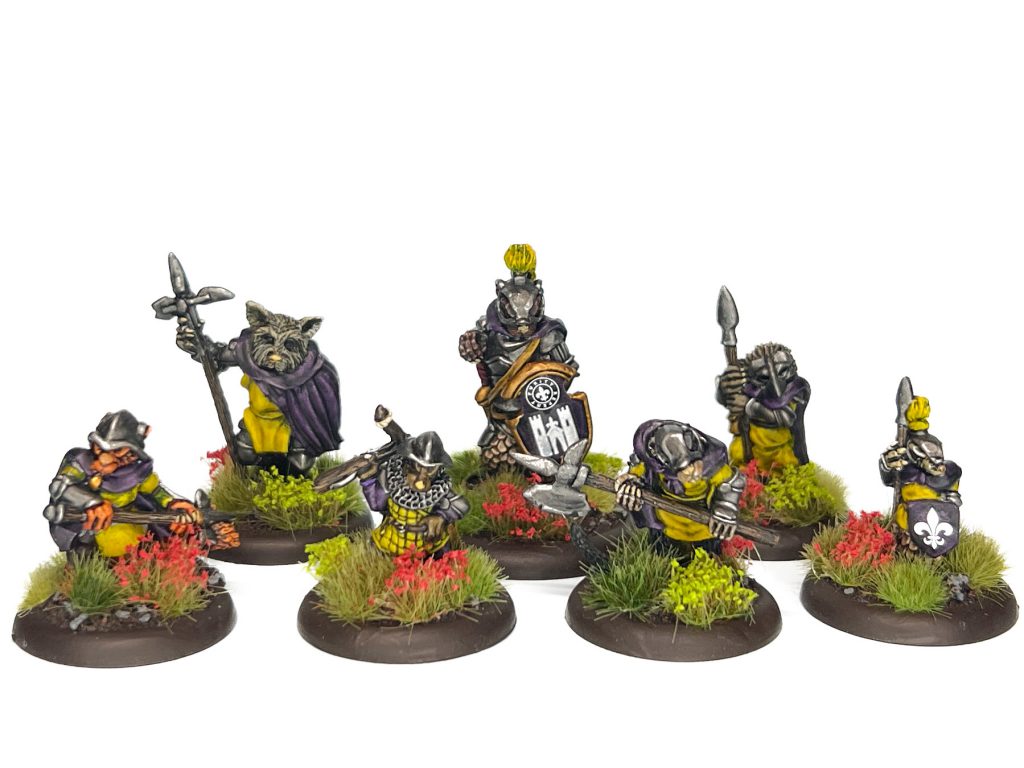
A big thanks again to Michael for sitting down with me an talking for a couple hours about miniatures, games, and all that he’s working on. He has a Kickstarter with a yet-to-be-determined date launching (probably) later in 2023 and you can follow this on the Burrows and Badgers Facebook page, which Oathsworn Minis runs, and on his own Instagram page. To browse all of their sculpts for Burrows and Badgers and Sensible Shoes (a more traditional-looking fantasy range) head to their website.
As always if you have any questions or suggestions, drop us a line at Contact@Goonhammer.com.

